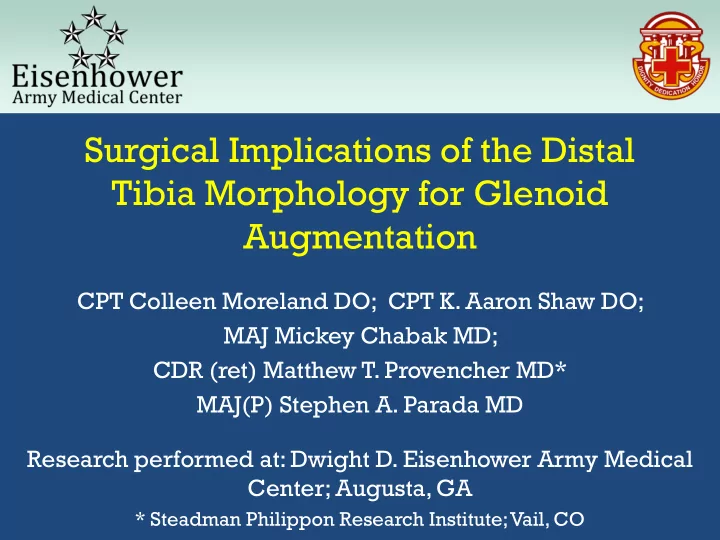

Surgical Implications of the Distal Tibia Morphology for Glenoid Augmentation CPT Colleen Moreland DO; CPT K. Aaron Shaw DO; MAJ Mickey Chabak MD; CDR (ret) Matthew T. Provencher MD* MAJ(P) Stephen A. Parada MD Research performed at: Dwight D. Eisenhower Army Medical Center; Augusta, GA * Steadman Philippon Research Institute; Vail, CO
• Some of the authors have disclosures that can be found in the AAOS database • No disclosures relate to this talk • Disclaimer: The views and opinions expressed in this article are those of the authors and do not necessarily reflect the official policy or position of any agency of the U.S. government.
Background • Anterior shoulder instability is common in young, athletic populations • Glenoid bone loss found in 90% • Soft tissue procedures in the setting of bone loss have high recurrence rate • Bony Reconstructive procedures exist – autograft coracoid (Latarjet), autograft iliac crest most common
Distal Tibia Allograft Benefits of DTA • Hyaline cartilage • Radius of curvature • Thickness of cartilage • Graft availability Potential Disadvantage • Variability of distal tibia
Variations in concavity at lateral edge necessitates graft contouring which removes cortical bone from lateral tibia affecting fixation
Distal Tibia Morphology Prior literature focuses on tibial morphology as it relates to the syndesmosis • Kennedy (2014): 33% flat • Taser (2009): 35% concave • Yildirim (2003): avg depth 3.6mm Purpose: Evaluate the morphology of the distal tibia at the articular surface regarding graft suitability for glenoid augmentation
Methods
Classification • Type A Flat lateral border, • no significant contouring
Classification • Type B • Depth of concavity < 5mm , suitable graft
Classification • Type C • Depth of concavity >5mm, graft not suitable
Results • 85 patients (62% male, avg 35.1 yr) • Strong inter-rater reliability – ICC 0.841 • Depth of Concavity (avg) – 1.6mm articular surface – 3.5mm physeal scar
Results • 85.9% of distal tibia suitable for glenoid augmentation with minimal contouring needed – 14% Type A, 72% Type B • Gender had significant effect on suitability of graft (P=0.004) – 100% females suitable vs 77% males
Surgeons now know the likelihood of obtaining a suitable distal tibia allograft with retained lateral cortex for glenoid reconstruction
Thank You
Recommend
More recommend